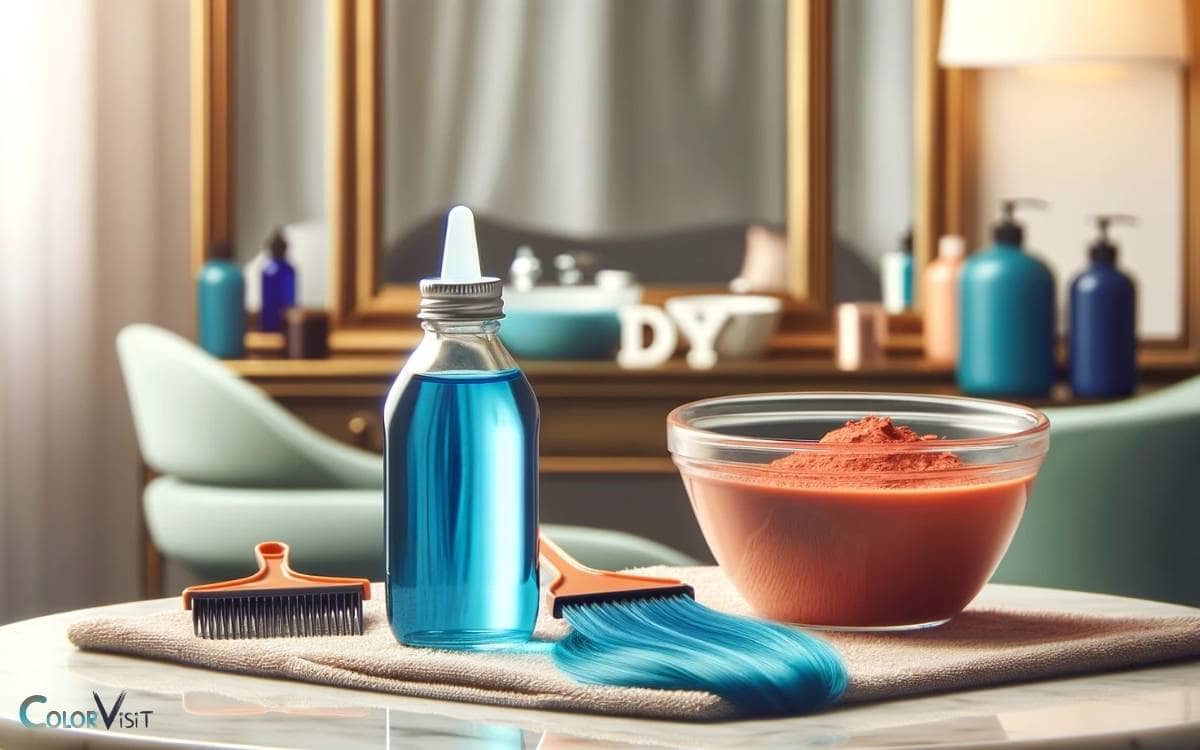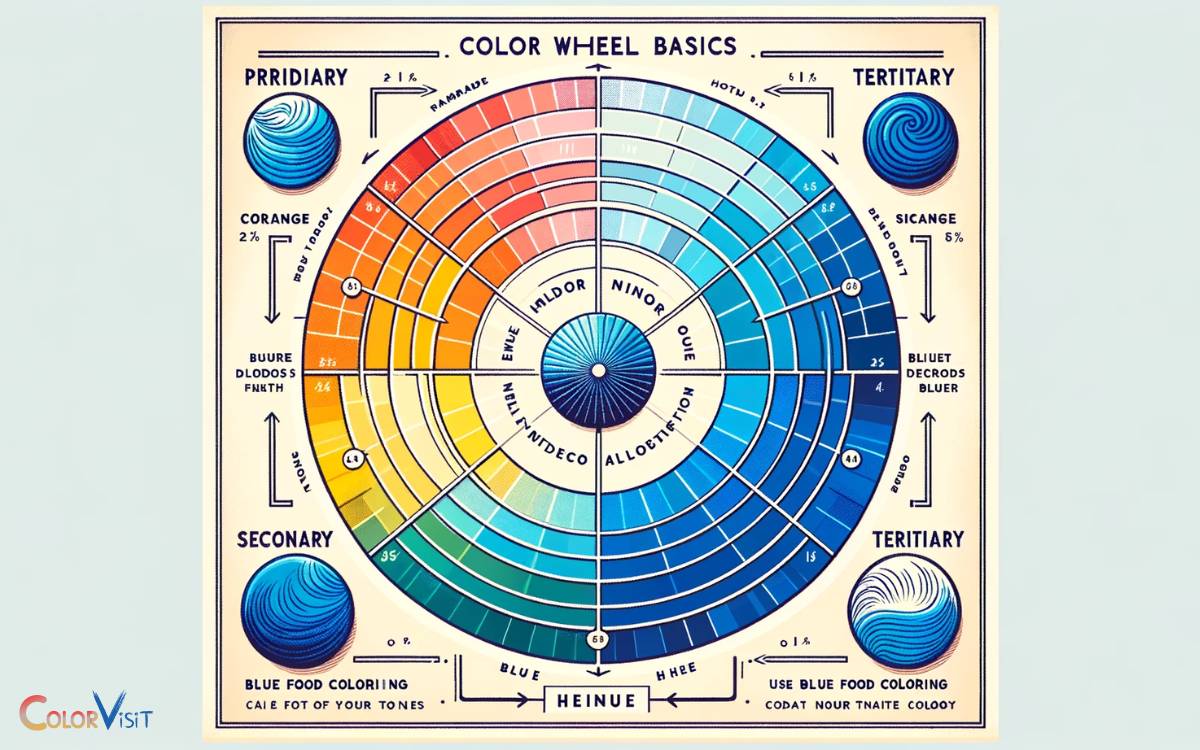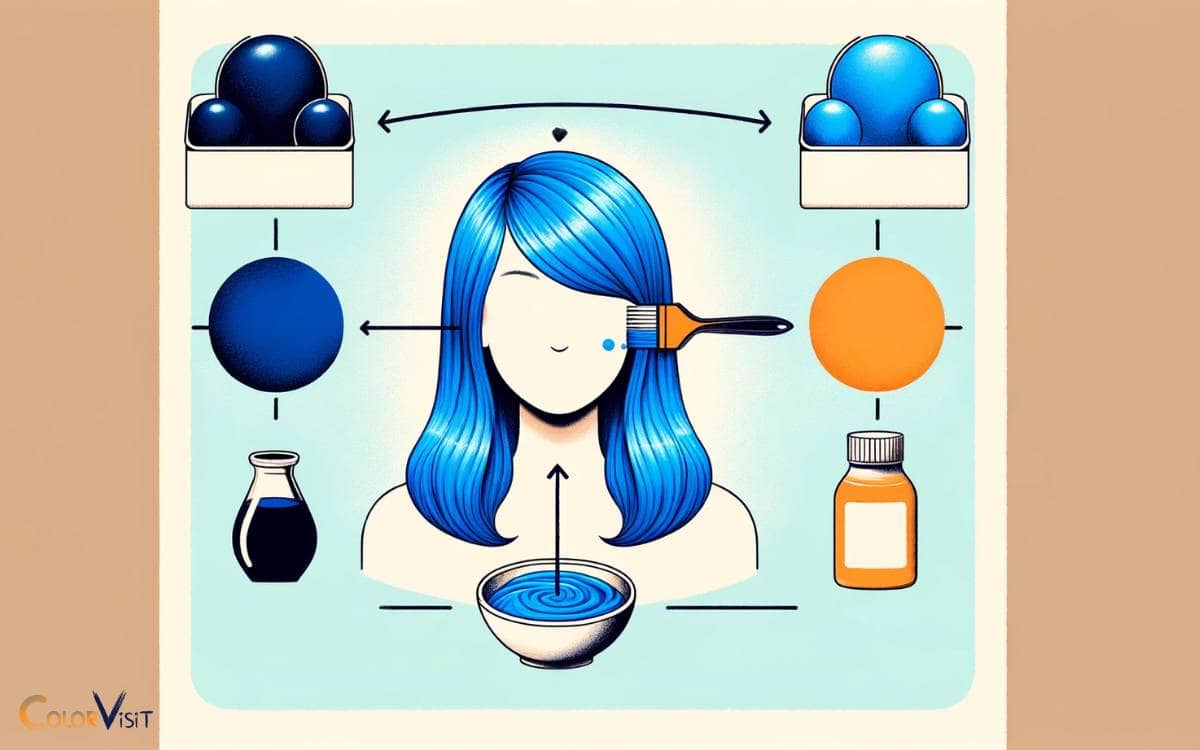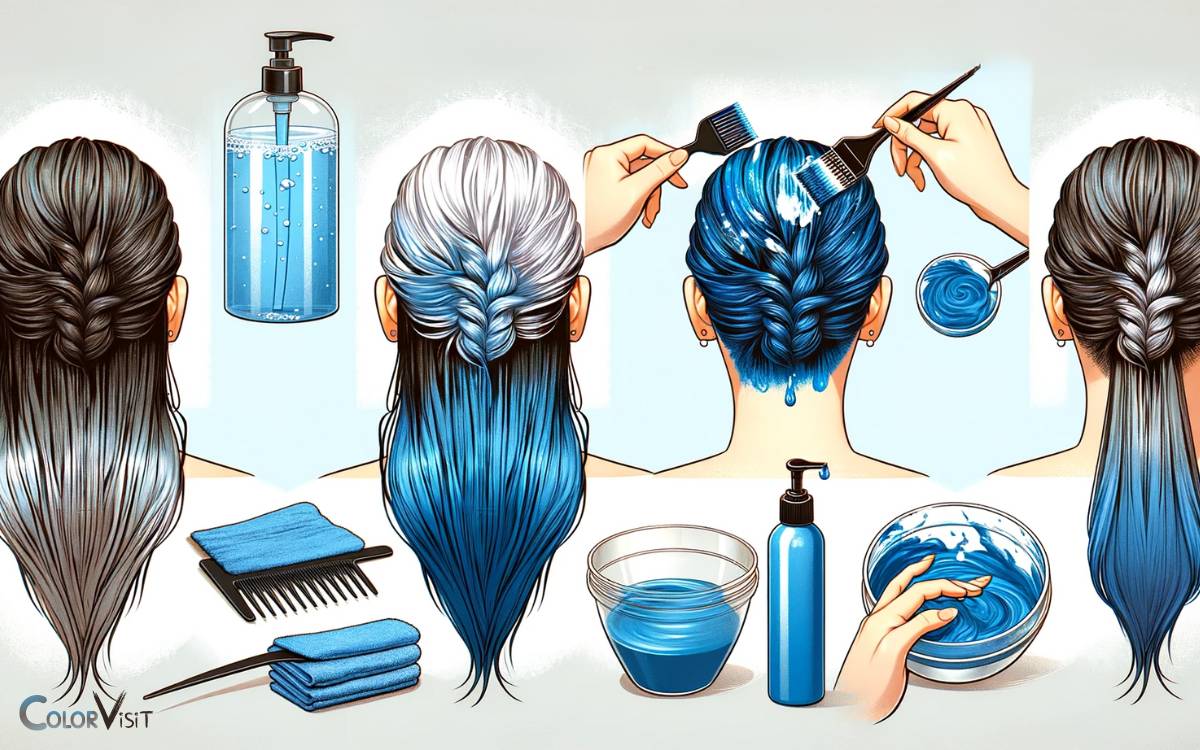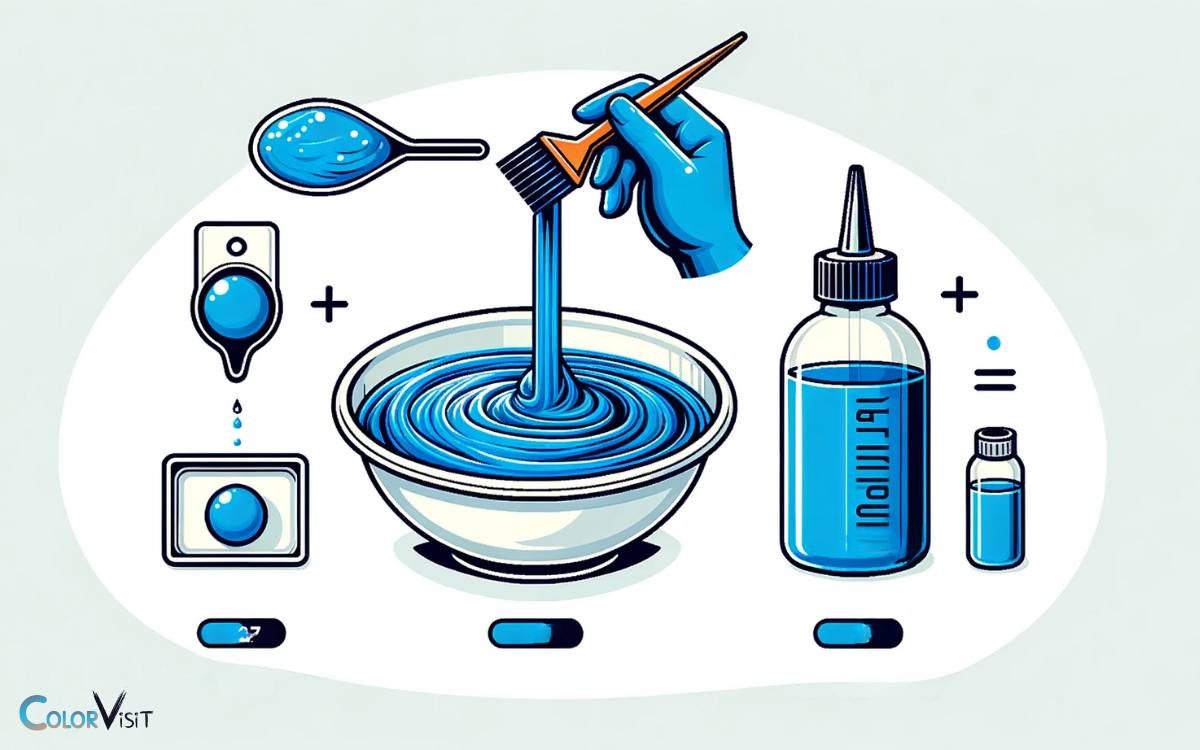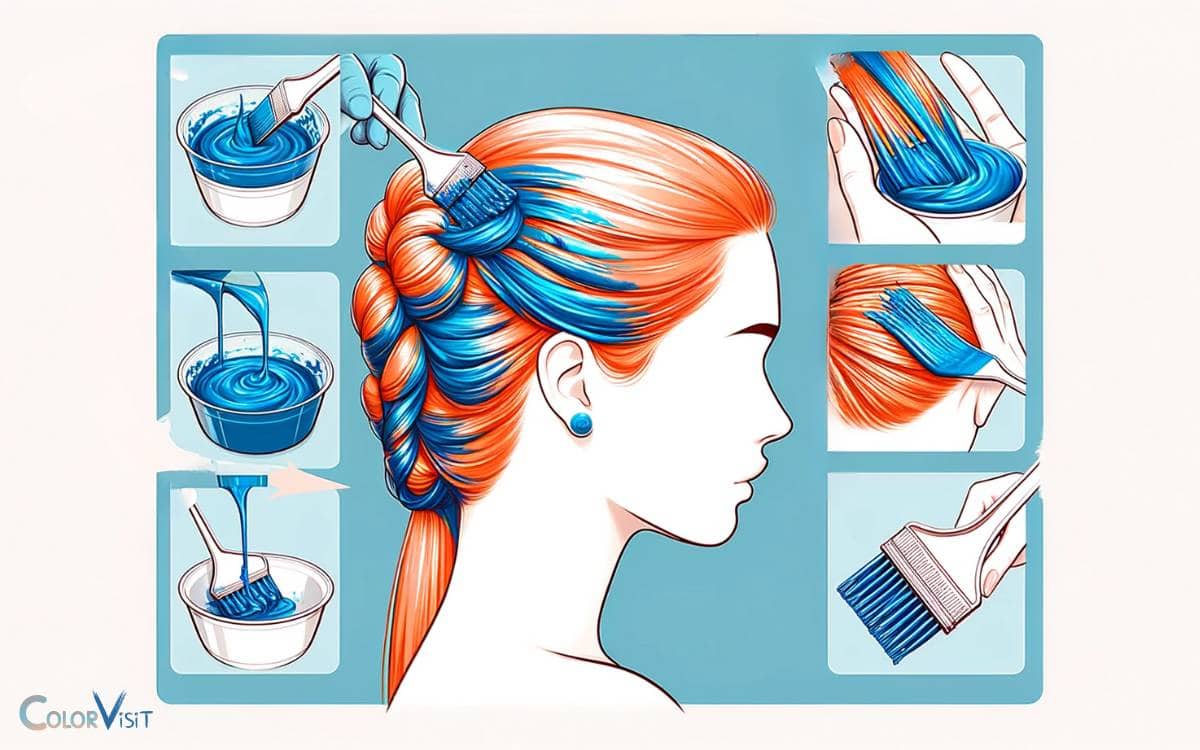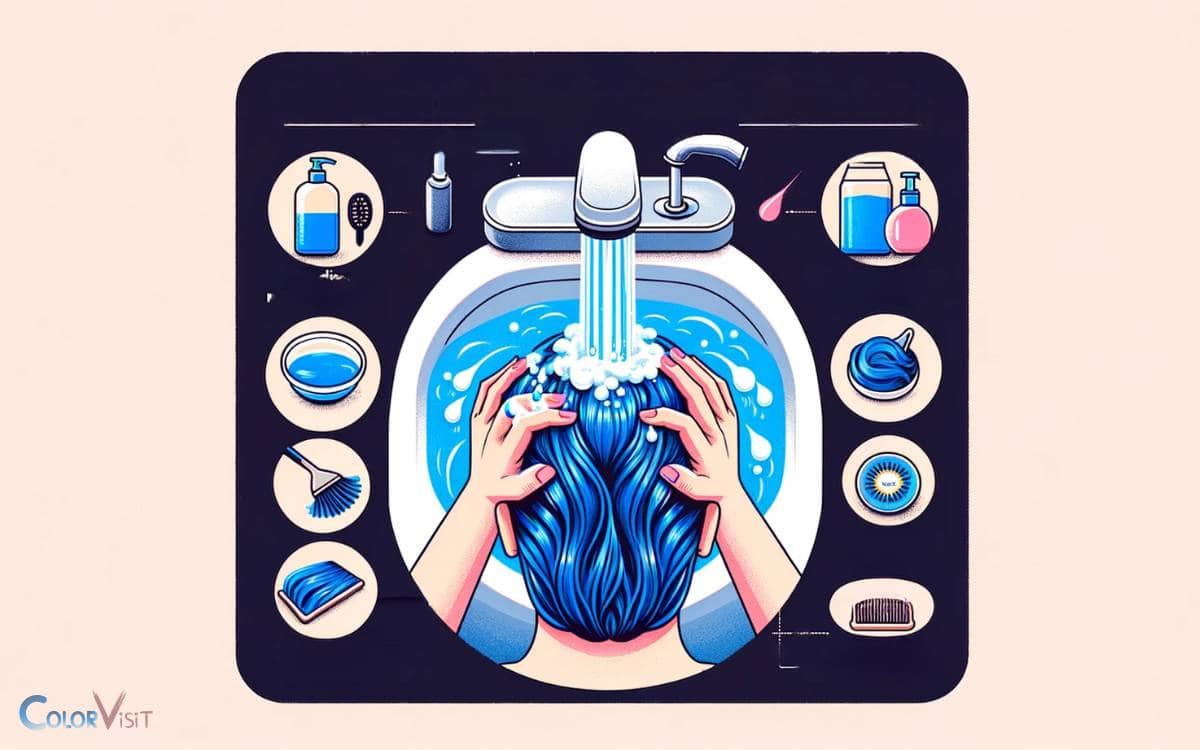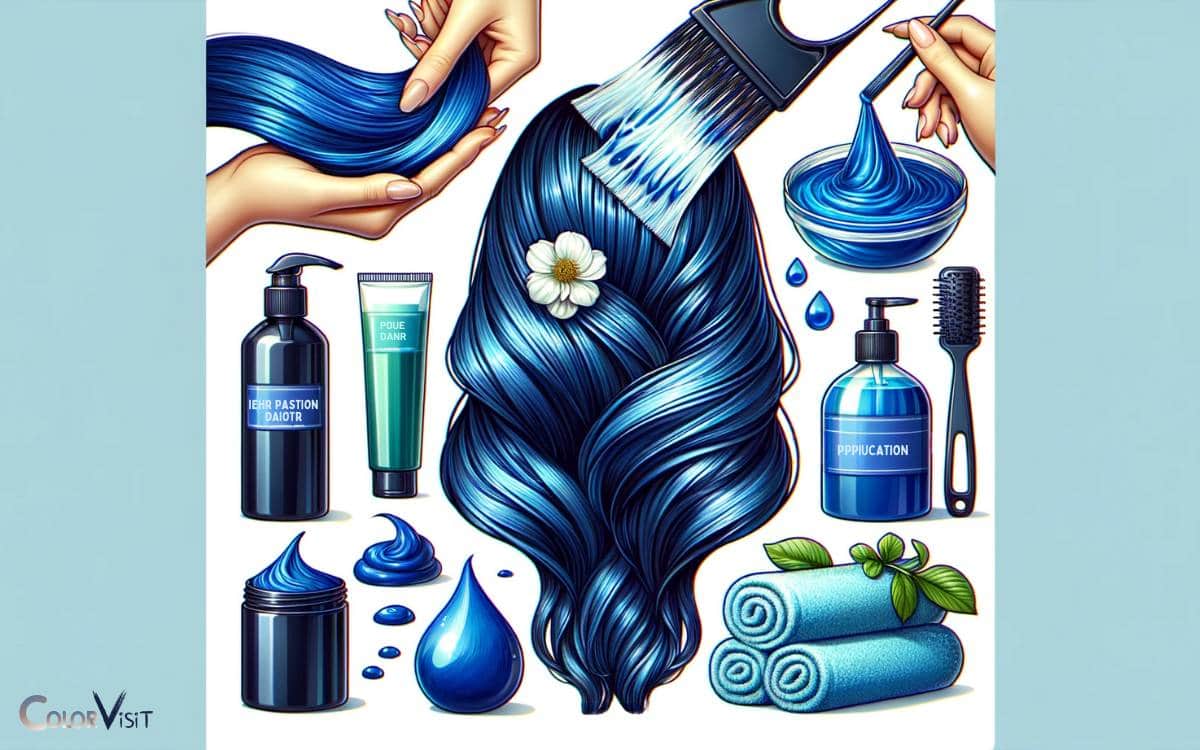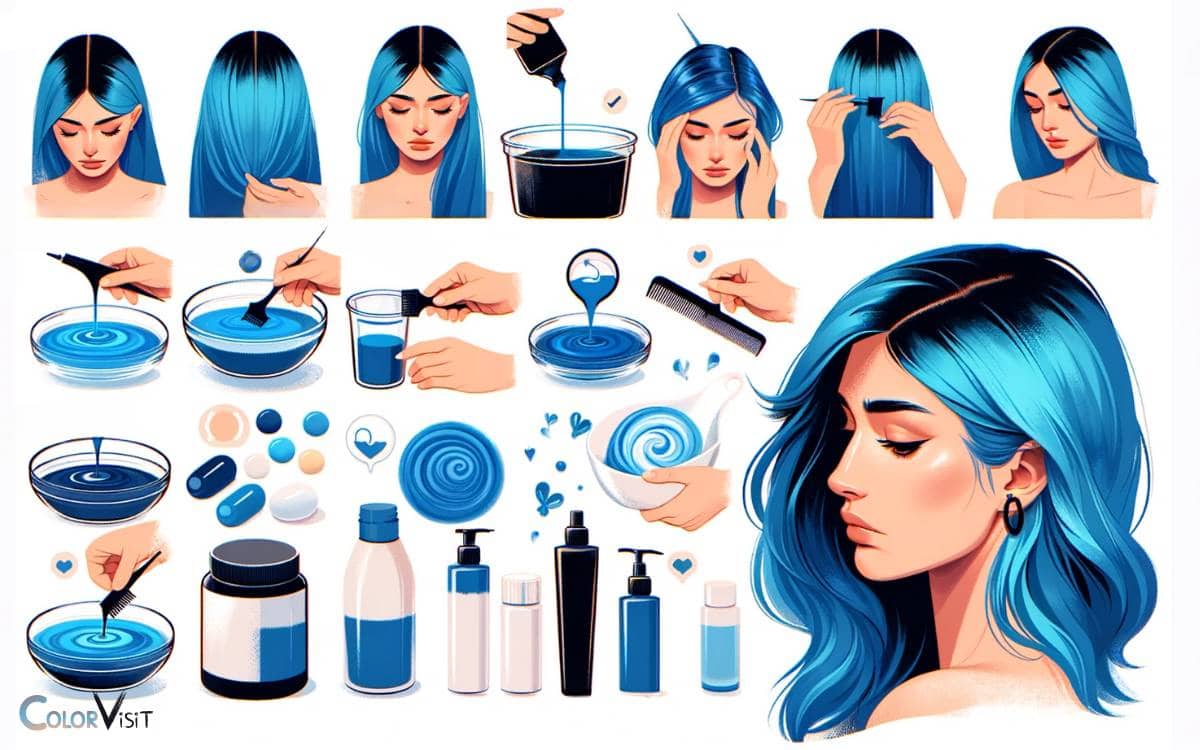Blue Food Coloring for Orange Hair: Bold Transformation!
The practice of applying blue food coloring to neutralize orange hues in hair has emerged as a cost-effective alternative to professional salon treatments.
This innovative method is grounded in color theory, specifically the color wheel, where blue and orange are complementary colors.
By applying blue to orange hair, these opposing colors cancel each other out, effectively neutralizing the unwanted orange tones.
This DIY approach not only offers a budget-friendly solution but also encourages individuals to explore creative hair care techniques from the comfort of their home.
To ensure the success and safety of this method, it’s crucial to understand the mechanics behind it, adhere to safety precautions, and follow the correct preparation steps.
Detailed Exploration of the Method:
Preparation Steps:
A person with lightened hair noticing orange tones can mix a few drops of blue food coloring with their conditioner, apply it to the affected areas, wait for 5-10 minutes, and then rinse.
This can significantly reduce the appearance of orange hues, leaving the hair with a more natural, cooler tone.
This simple yet effective method not only saves money but also empowers individuals to take control of their hair’s appearance, fostering creativity and self-reliance in personal grooming.
Key Takeaway
The Color Wheel Basics
Understanding the color wheel is fundamental in grasping how blue food coloring can effectively neutralize orange tones in hair.
This concept is rooted in color theory, a cornerstone of visual arts and design that explains how colors interact and influence each other.
The color wheel itself is a structured visual representation of colors arranged according to their chromatic relationship.
Primary colors, secondary colors, and tertiary colors are positioned in a way that facilitates understanding of color harmony, contrast, and balance.
For individuals aiming to innovate in hair care and color correction, a profound comprehension of the color wheel is indispensable.
It enables the strategic application of contrasting colors to achieve desired outcomes, laying the groundwork for advanced techniques in hair coloration and treatment.
Why Blue Neutralizes Orange
Why does blue effectively neutralize orange tones in hair? This phenomenon can be elucidated through an analysis of complementary colors on the color wheel.
When striving for hair color correction, understanding the foundational principles of color theory is paramount.
- Complementary Colors: Blue and orange are opposite each other on the color wheel, making them complementary. This opposition means that when applied together, they cancel each other out, leading to a neutralizing effect.
- Color Absorption: Hair strands absorb the blue pigment, which then counteracts the visible orange hues, effectively diminishing the warm tones.
- Perception Shift: The application of blue alters the way light reflects off the hair, changing the perceivable color and resulting in a more natural, desired tone.
This technical approach allows for targeted and innovative solutions in hair color treatment, offering a precise and analytical method for achieving desired outcomes.
Safety Precautions
While exploring the effectiveness of blue food coloring for neutralizing orange hues in hair, it is critical to consider the safety precautions associated with its application.
The innovative approach of using food coloring as a toner requires not only an understanding of color theory but also an awareness of the potential risks and how to mitigate them.
| Concern | Mitigation Strategy |
|---|---|
| Skin Sensitivity | Perform a patch test. |
| Staining | Use gloves and protective clothing. |
| Allergic Reactions | Consult a dermatologist prior to application. |
Choosing the Right Blue
Selecting the appropriate shade of blue food coloring is a critical step in effectively neutralizing unwanted orange tones in hair.
The choice of blue is paramount, as it directly influences the outcome of this innovative color-correction technique.
To ensure optimal results, consider the following:
- Intensity of Blue: A deep, vibrant blue is essential for canceling out strong orange hues, whereas lighter shades may be effective for subtle adjustments.
- Purity of Color: Opt for food coloring that does not contain additional hues that could alter the desired neutralization effect.
- Compatibility with Hair Type: Understand the porosity and health of the hair to predict how it will absorb the blue pigment, adjusting the selection accordingly for a precise, targeted approach to color correction.
Preparing Your Hair
After choosing the correct shade of blue food coloring for neutralizing orange hair tones, the next essential step involves preparing the hair to ensure it effectively absorbs the pigment.
This preparation phase is critical, employing a meticulous approach to maximize the toning effects while preserving hair integrity.
Initially, cleansing the hair with a clarifying shampoo is imperative to remove any residual products, oils, and build-up, establishing a clean slate. This process optimizes the hair’s porosity, enhancing the food coloring’s penetration.
Following cleansing, gently drying the hair to a slightly damp state is recommended, as this condition is most conducive for the pigment’s absorption.
Avoiding the application of conditioners or any products that could form a barrier is crucial, ensuring the hair remains in an optimal state for receiving the blue food coloring treatment.
Mixing the Solution
To ensure optimal results in neutralizing orange hair tones, it is imperative to accurately mix the blue food coloring with a suitable diluting agent, such as conditioner or water, in precise proportions.
This process requires a meticulous approach to achieve the desired tonal adjustment without compromising hair integrity.
- Measurement Precision: Begin by determining the level of orange undertones present. This assessment will guide the ratio of blue food coloring to the diluting agent, ensuring a targeted approach to color correction.
- Uniformity in Mixing: Achieve a homogenous mixture by stirring continuously, preventing any uneven distribution of pigment which could result in patchy results.
- Adjustment and Testing: Before application, it’s advisable to test the mixture on a small hair section. This preliminary step allows for adjustments in concentration, ensuring the mixture’s efficacy in neutralizing orange hues without inducing undesired overtones.
Employing this technical, analytical methodology caters to those seeking innovative yet precise solutions in hair color correction.
Application Process
Once the blue food coloring solution has been meticulously prepared and tested, the next critical step involves its precise application to the orange-toned hair areas.
Achieving optimal results requires an analytical approach, focusing on uniform distribution to ensure even neutralization of orange hues.
Utilizing a fine-toothed comb, the solution should be applied section by section, starting from the roots and gradually moving towards the ends to maintain consistency in color correction.
This method allows for a targeted application, minimizing the risk of uneven saturation which can lead to patchy results.
It’s imperative to work with precision, as the meticulous application is key to achieving a harmonious, desired shade.
Each strand must be thoroughly coated to ensure comprehensive coverage, setting the stage for an effective neutralization process.
Timing Is Key
Understanding the precise duration for which the blue food coloring solution should remain on the hair is crucial for achieving the intended color correction without causing damage.
The timing can vary depending on several factors, which need careful consideration:
- Hair Porosity: Highly porous hair absorbs color faster, requiring shorter application times.
- Desired Shade: Subtler corrections may need less time than more dramatic shifts from orange to a neutral or ash tone.
- Previous Treatments: Chemically treated or damaged hair may react unpredictably, necessitating careful monitoring.
An analytical approach, combining these factors, helps in determining the optimal duration, usually ranging between 5 to 30 minutes.
Precision in timing not only ensures the effectiveness of the color correction but also minimizes the risk of hair damage, leading to a successful and innovative solution for unwanted orange tones.
Rinsing It Out
Following the application of blue food coloring to counteract orange tones in hair, the process of rinsing it out is critical for achieving the desired outcome.
Factors such as the duration of the rinse and the temperature of the water can significantly influence the effectiveness of the treatment and the final hair color.
Additionally, implementing appropriate post-rinse hair care routines is essential to maintain the hair’s health and color stability.
Rinse Duration Tips
Determining the optimal duration for rinsing out blue food coloring from orange hair is critical for achieving the desired shade without compromising hair health.
The rinsing process must be executed with precision to ensure that the color adheres properly while preserving the integrity of the hair.
Here are three key tips:
- Initial Assessment: Begin with a rinse duration of 2-3 minutes, observing the color intensity.
- Adjustment Phase: If the desired shade is not achieved, incrementally increase the duration by 1-minute intervals, carefully monitoring the changes.
- Final Rinse: Once the optimal shade is reached, perform a final rinse for 30 seconds to ensure any residual dye is removed.
This systematic approach allows for a controlled manipulation of the dyeing process, ensuring a balanced outcome that aligns with innovative hair coloring techniques.
Water Temperature Effect
The temperature of the water used during the rinsing process plays a pivotal role in the final appearance and health of hair dyed with blue food coloring.
Utilizing cooler water temperatures is recommended, as it aids in sealing the hair’s cuticle, thus locking in the pigment for a more vibrant, lasting color.
Conversely, hot water can strip the hair of its natural oils along with the applied color, leading to a faded appearance and diminished hair integrity over time.
Analytically, the molecular interaction between the hair cuticle and the pigments from the food coloring is optimized at lower temperatures, promoting better color retention and minimizing damage.
This technical insight empowers individuals seeking innovative hair coloring solutions to make informed decisions for optimal results.
Post-Rinse Hair Care
After the rinsing process, implementing a meticulous post-rinse hair care regimen is crucial for maintaining the structural integrity and vibrancy of hair dyed with blue food coloring.
The following steps are essential:
- Application of a pH-Balanced Conditioner: Immediately applying a conditioner that is pH-balanced ensures the cuticles of the hair close properly, locking in the blue pigment and preventing rapid fading. This step is fundamental in preserving the color’s intensity.
- Cold Water Final Rinse: A final rinse with cold water further seals the cuticles and enhances shine, contributing to the longevity of the hair color.
- Leave-In Treatments: Incorporating leave-in treatments that contain UV protection and hydration components can protect the hair from environmental factors that tend to dull the color and lead to premature fading.
Adherence to this regimen supports sustained color vibrancy and hair health.
Post-Application Care
Proper post-application care is crucial for maintaining the desired hue and ensuring the longevity of the blue color treatment in orange hair.
Following application, it is imperative to implement a regimen that includes the use of color-safe shampoos and conditioners.
These products are specifically formulated to gently cleanse without stripping the hair of its newly acquired pigment.
Moreover, the application of a leave-in conditioner or hair mask once a week can deeply nourish and protect the hair fibers, thereby reducing the likelihood of color fading.
Additionally, minimizing heat styling and exposure to sunlight can significantly prolong the vibrancy of the blue tone.
Adopting these post-application care steps will not only preserve the color but also contribute to the overall health and resilience of the hair.
Expected Results
Implementing the recommended post-application care regimen sets the stage for achieving optimal results, where the blue color manifests vividly on orange hair, showcasing a striking contrast and uniform saturation across strands.
The expected outcomes, contingent upon precise adherence to the application and maintenance instructions, are:
- Intense Color Vibrancy: The chemical properties of the blue food coloring, when correctly applied, penetrate the hair shaft, ensuring the pigment’s longevity and vibrancy.
- Minimal Color Fading Over Time: Proper post-application care significantly reduces the rate of color degradation, preserving the intensity of the blue hue.
- Uniform Color Distribution: Achieving an even application results in uniform color distribution, eliminating patchiness and ensuring a cohesive look.
These results epitomize the innovative approach to hair coloring, promising a unique and visually appealing transformation.
Troubleshooting Tips
In the process of utilizing blue food coloring for correcting orange hues in hair, it is critical to address potential challenges such as fixing uneven tones and maintaining color vibrancy over time.
Strategies for evenly distributing the pigment and ensuring long-lasting results require meticulous application techniques and aftercare practices.
This section will provide detailed guidance on refining these aspects, thereby optimizing the efficacy of blue food coloring as a toning agent.
Fixing Uneven Tones
Addressing uneven tones in orange hair necessitates a careful application of blue food coloring, following a specific ratio and technique to ensure balanced color correction.
The process is methodical, requiring precision to avoid overcorrection and ensure uniformity across all hair sections.
To achieve this, consider the following steps:
- Identify the Areas of Discrepancy: Before application, thoroughly evaluate the hair to pinpoint the uneven orange tones. This step is crucial for targeted correction.
- Mix with Conditioner: Dilute blue food coloring with a white conditioner in a 1:2 ratio. This mixture allows for a more controlled and even application, reducing the risk of overtreatment.
- Gradual Application: Start with a conservative amount, applying the mixture to the identified sections first. Observe the tonal change and adjust the application as necessary to achieve a uniform color.
This analytical approach ensures a precise and effective tonal correction, catering to an audience that values innovation and meticulousness in hair care.
Maintaining Color Vibrancy
Maintaining the vibrancy of color-treated hair requires a systematic approach to prevent fading and preserve the desired hue.
This involves the strategic application of blue food coloring, an innovative method to counteract orange brassiness, particularly in lightened hair.
To ensure longevity, it’s crucial to integrate a maintenance schedule that includes the periodic application of a diluted blue food coloring solution, tailored to the specific shade and intensity of the orange tones.
Furthermore, protecting the hair from factors that expedite color degradation—such as UV exposure, harsh chemical products, and high-temperature styling tools—is imperative.
Utilizing UV-protective hair products, sulfate-free shampoos, and conditioners, and minimizing thermal styling will significantly contribute to maintaining color vibrancy.
This analytical approach ensures the prolonged enjoyment of the desired hair color, promoting both hair health and color stability.
Alternative Methods
Exploring alternative methods, one can leverage the potential of natural dyes and color-correcting shampoos to counteract orange tones in hair, thus expanding the palette of solutions beyond conventional blue food coloring.
This approach not only broadens the scope of corrective measures but also introduces a nuanced understanding of hair care dynamics.
- Natural Dyes: Ingredients such as indigo and black walnut powder offer sustainable, albeit less predictable, results. Their application requires precise formulation to achieve the desired shade correction.
- Color-Correcting Shampoos: Specifically formulated shampoos with blue or purple pigments can neutralize orange hues through regular use, providing a non-invasive alternative.
- Toner Treatments: Professional toners can be fine-tuned to address specific color imbalances, offering a tailored solution for more severe discolorations.
These alternatives represent a sophisticated approach to managing unwanted hair color, appealing to those seeking innovative and effective solutions.
Maintaining Your Color
Having considered the various methods for correcting orange tones in hair, it is crucial to focus on strategies for preserving the achieved color balance over time. To maintain the desired hue, regular touch-ups with color-safe shampoos and conditioners can help prevent unwanted fading. Additionally, utilizing products specifically designed for color correction, like “color oops for orange hair,” can effectively neutralize any emerging warmth. Consistent care and the right maintenance products are key to extending the vibrancy of your color-treated hair.
Post-treatment, the application of color-protective shampoos and conditioners, specifically formulated to minimize pigment washout, plays a pivotal role.
These products often contain pH-balancing ingredients that seal the hair cuticle, reducing the risk of color fading.
Additionally, the integration of UV-protective products into one’s hair care routine can substantially mitigate the deleterious effects of sun exposure, which accelerates color degradation.
Furthermore, periodic maintenance sessions, utilizing a diluted blue food coloring mask, can assist in maintaining the neutralization of orange hues, ensuring the longevity of the color correction.
Such an analytical approach underscores the importance of a tailored, systematic regimen for sustaining hair color integrity.
Conclusion
The application of blue food coloring as a countermeasure against the undesired orange hues in hair stands as a testament to the ingenuity inherent in color theory application.
By meticulously adhering to safety protocols, selecting the optimal shade of blue, and ensuring proper hair preparation, individuals can achieve results that border on alchemical transformation.
However, this process requires a sagacious approach to troubleshooting and maintenance, underscoring the intricate dance between art and science that defines the realm of hair color correction.
